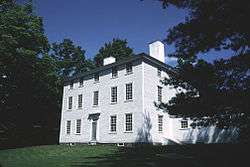Pownalborough Courthouse
|
Pownalborough Courthouse | |
 | |
  | |
| Location | 23 Courthouse Rd. (off Cedar Grove Rd.), Dresden, Maine |
|---|---|
| Coordinates | 44°6′19″N 69°45′59″W / 44.10528°N 69.76639°WCoordinates: 44°6′19″N 69°45′59″W / 44.10528°N 69.76639°W |
| Area | 56 acres (23 ha) |
| Built | 1761 |
| Architect | Flagg,Gersham |
| NRHP Reference # | 70000052[1] |
| Added to NRHP | January 12, 1970 |
The Pownalborough Courthouse is a historic court house at 23 Courthouse Road in Dresden, Maine. Built in the early 1760s, it was the first county courthouse for Lincoln County, which was established in 1760. It is the only surviving courthouse in the state of Maine that was built during the colonial period, and is now a museum owned and operated by the Lincoln County Historical Society. It was listed on the National Register of Historic Places in 1970.[1]
Description and history
The Pownalborough Courthouse stands in what is now a rural area of western Dresden, overlooking the Kennebec River just to the west. It stands on grounds that were at the time of its construction the site of Fort Shirley, one of the first inland forts built by the British on the river. The courthouse has a roughly square three-story main block, framed in wood, covered by a hip roof, and clad in wooden clapboards. The main facade is five bays wide, with a center entrance flanked by pilasters and topped by an entablature and cornice. A single-story wing extends to one side. The interior has seen a variety of alterations, but retains original wide flooring. It has never been fitted with electricity or modern plumbing.[2]
Lincoln County was separated from York County, Massachusetts (Maine then being part of Massachusetts) in 1760. It was named for Governor Thomas Pownall, and the town of Pownalborough (encompassing modern Dresden, Alna, Jefferson, and Wiscasset) was named in his honor. The proprietors who owned the land voted to build a courthouse that year, to be located on the grounds of Fort Shirley, which had been built in 1752 as a defense against Native American attacks. The fort's importance had declined since the construction of Fort Western further upriver, and it was thought that its facilities could be used to house a jail and keeper's quarters. Construction began on the courthouse in 1761, and the county's first court session was held in the unfinished building later that year. The building was not completed until 1769. In addition to housing the court facilities, the building also served as a tavern, post office, meeting house, and had living quarters on the third floor. Those quarters were occupied by the fort commander, Major Samuel Goodwin, and were continuously occupied by his descendants into the 1930s. The local historical society purchased the 56-acre (23 ha) property from Goodwin's descendants in 1954.[2] It is now open seasonally (Memorial Day to Columbus Day) as a museum dedicated to local history; admission is charged.
See also
References
- 1 2 National Park Service (2009-03-13). "National Register Information System". National Register of Historic Places. National Park Service.
- 1 2 Frank Beard (1983). "NRHP nomination for Pownalborough Courthouse" (PDF). National Park Service. Retrieved 2016-06-15. with photos from 1968